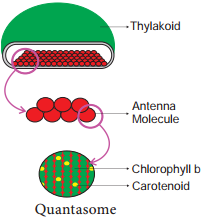Learninsta presents the core concepts of Biology with high-quality research papers and topical review articles.
Photosynthetic Unit (Quantasome)
Quantasomes are the morphological expression of physiological photosynthetic units, located on the inner membrane of thylakoid lamellae. Each quantasome measures about 180 A° × 160 A° and 100 A° thickness. In 1952, Steinman observed granular structures in chloroplast lamellae under electron microscope. Later, Park and Biggins (1964) confirmed these granular structures as physiological units of photosynthesis and coined the term Quantasome.
According to them one quantasome contains about 230 chlorophyll molecules. A minimum number of chlorophyll and other accessory pigments act together in a photochemical reaction to release one oxygen or to reduce one molecule of CO2. It constitutes a photosynthetic unit. (Figure 13.6) Emerson and Arnold (1932) based on flashing light experiment found 2500 chlorophyll molecules are required to fix one molecule of CO2.

However, the reduction or fixation of one CO2 requires 10 quanta of light and so each unit would contain 1/10 of 2500 i.e. 250 molecules. Usually 200 to 300 chlorophyll molecules are considered as a physiological unit of photosynthesis. According to Emerson 8 quanta of light are required for the release of one oxygen molecule or reduction of one Carbon dioxide molecule. The quantum yield is 1/8 or 12%.
Quantasomes are particles found in the thylakoid membrane of chloroplasts in which photosynthesis takes place. They are composed of lipids and proteins that include various photosynthetic pigments and redox carriers. For this reason they are considered to be photosynthetic units.
The photosynthetic unit is experimentally defined as the number of oxygen. molecules evolved or carbon dioxide molecules reduced per molecule of chlorophyll when the chloroplast pigments are excited by one flash of light so.
Quantasomes are particles found in a paracrystalline array of the thylakoid membrane of chloroplasts in which photosynthesis takes place. They are believed to be the structural and functional units of the chloroplast.
The cell is the smallest structural and functional unit of living organisms, which can exist on its own. Therefore, it is sometimes called the building block of life. Some organisms, such as bacteria or yeast, are unicellular consisting only of a single cell while others, for instance, mammalians, are multicellular.
Quantasomes are particles found in the thylakoid membrane of chloroplasts in which photosynthesis takes place. They occur in 2 sizes: the smaller quantasome is thought to represent the site of photosystem I, the larger to represent the site of photosystem II.
The two stages of photosynthesis: Photosynthesis takes place in two stages: light-dependent reactions and the Calvin cycle (light-independent reactions). Light-dependent reactions, which take place in the thylakoid membrane, use light energy to make ATP and NADPH.
The average minimal quantum number remains 10 (efficiency 0.1) as in many algae and typical higher plants. Most of the time the optimal efficiency depends on the availability of some far-red radiation, particularly in the blue region of the spectrum where blue light alone is rather inefficient.
Cyclic photophosphorylation can be defined as the synthesis of ATP coupled to electron transport activated by Photosystem I solely, and can therefore proceed in long-wave-length light (03BB 2265 700 nm). This proces is unaffected by the specific inhibitors of Photosystem II, such as CMU, DCMU and orthophenanthroline.
The reaction centre contains pigments such as chlorophyll and phaeophytin. These absorb light, promoting an electron to a higher energy level within the pigment. The free energy created is used to reduce an electron acceptor and is critical for the production of chemical energy during photosynthesis.
The chlorophyll molecules are grouped into antenna complexes, clusters of several hundred molecules that are anchored onto the thylakoid membrane by special proteins. Within each antenna complex is a specialized set of proteins and chlorophyll molecules that form a reaction.
As you rise from low light intensity to higher light intensity, the rate of photosynthesis will increase because there is more light available to drive the reactions of photosynthesis. At a very high intensity of light, the rate of photosynthesis would drop quickly as the light starts to damage the plant.
Chlorophyll a is the most important photosynthetic pigment because it is directly involved in the conversion of light energy (photons) to chemical energy. All other photosynthetic pigments found in the chloroplasts of higher plants are called “accessory pigments”.